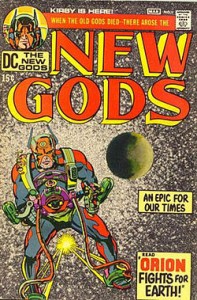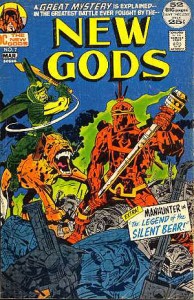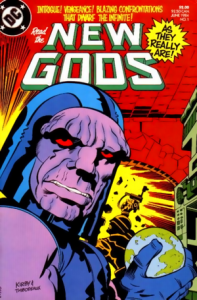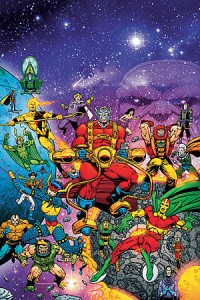New Gods

World of the New Gods
The history of New Genesis and Apokolips, and the birth of the New Gods in Superman the Animated Series. Property of Warner Brothers. From the third season, Apokolips Now! Part 1.
 Cover to The New Gods (vol. 1) #1 (February/March 1971). Art by Jack Kirby and Don Heck.
Cover to The New Gods (vol. 1) #1 (February/March 1971). Art by Jack Kirby and Don Heck.
The New Gods are a fictional race appearing in publications by DC Comics, as well as the title for four series of comic books about those characters. They first appeared in New Gods #1 (February 1971) and were created and designed by Jack Kirby.
Publication history
The New Gods are natives of the twin planets of New Genesis and Apokolips. New Genesis is an idyllic planet filled with unspoiled forests, mountains, and rivers and is ruled by the benevolent Highfather, while Apokolips is a nightmarish, ruined dystopia filled with machinery and fire pits and is ruled by the tyrant Darkseid. The two planets were once part of the same world, a planet called Urgrund (German for “primeval ground”), but it was split apart millennia ago after the death of the Old Gods during Ragnarök. The characters associated with the New Gods are often collectively referred to as “Jack Kirby’s Fourth World“. The New Gods first appeared in New Gods #1 and Mister Miracle#1 (both titles were published concurrently). The other two “Fourth World” titles were Superman’s Pal Jimmy Olsen and Forever People. Various New Gods, notably Darkseid, went on to interact with other denizens of the DC Universe.
The opening sequence of New Gods #1 references the “Old Gods” and the “New Gods” (e.g., “There came a time when the Old Gods died…“). In a “Young Gods of Supertown” back-up story in Forever People #5, the explorer Lonar retrieves a helmet from the rubble of what represents the last battle of the Old Gods. The helmet closely resembles that worn by the Marvel Comics character Thor, a character whom Kirby drew for several years.
After leaving DC Comics and returning to Marvel Comics, Kirby went on to create a similar concept in the Eternals.
In Grant Morrison‘s Final Crisis, they are again featured, but are depicted as beings of immense power, enough to warrant the Green Lantern Corps investigating the murder of Orion.
Publication history by volume
 Cover to The New Gods(vol. 1) #7 (February/March 1972), featuring “The Pact”. Art by Jack Kirby.
Cover to The New Gods(vol. 1) #7 (February/March 1972), featuring “The Pact”. Art by Jack Kirby.
Volume One (1971)
New Gods #1 would mark the first appearance of Orion, Highfather, and Metron, among others; and further issues into the series would mark the first appearance of many other Fourth World characters, as well as explaining key concepts about the New Gods. Of note was issue #7, “The Pact”, which sought to explain the backstory of the New Gods. Eleven issues were published before cancellation by the publisher. Simultaneously published during this time were the Forever People and Mister Miracle series, also written and drawn by Kirby. All three series saw reprint in black and white form by DC Comics in 1998. In 2007 and 2008, the Jack Kirby’s Fourth World Omnibus reprinted the series, along with Kirby’s other Fourth World stories, in color and in published chronological order.
Return of the New Gods (1977)
In 1977, DC revived the New Gods series, under the title Return of the New Gods as part of the “DC Explosion” launch of 1977. The first new story was in the last issue of DC’s 1st Issue Special#13, shortly followed by a relaunch. Despite the new title, the series retained its original numbering, running from #12-19. Gerry Conway would write the series, with Don Newton providing the pencils. The series was controversial for featuring a new, more mainstream superhero costume for Orion, which he would wear for the next few years.
The series was cancelled almost as soon as it had been revived, due to the “DC Implosion“, where a variety of market-related factors caused DC to cancel almost all of the titles launched the previous year.
Adventure Comics and the Justice League
Due to the abrupt cancelling of the revived series, DC Comics decided to try to bring the series to an end with a special two part storyline in the pages of the Adventure Comics anthology series. Adventure Comics #459-460 (1978) featured a climactic battle between Darkseid’s forces and the New Gods, culminating in Darkseid’s defeat and apparent “death.”
Another story appeared in Super-Team Family #15 (1978).
Darkseid’s “death” would quickly be overturned in the New Gods’ next appearance in Justice League of America #183-185. The three part storyline would tell of Darkseid’s return to Apokolips and his scheme to destroy Earth-Two and teleport Apokolips into its place, so that he could conquer a new universe devoid of the New Gods. The plan would be foiled, however, by the combined power of the New Gods, the Justice League, and the Justice Society.
Volume Two (1984)
 Cover to New Gods (vol. 2) #1 (June 1984). Art by Jack Kirby.
Cover to New Gods (vol. 2) #1 (June 1984). Art by Jack Kirby.
Essentially a reprint series, this volume packaged two issues apiece per single issue of the original 1971 series. The mini-series’ final issue was originally intended to include a reprint of New Gods(vol. 1) #11 and a new 24-page story which would conclude the series and end with both Darkseid and Orion dead. However, DC editors prevented Kirby from using his original intended ending. Kirby instead turned in a one-off story called “On the Road to Armagetto” which was also rejected, due to the fact that it did not contain a definitive ending to the series.
A 48-page new story called “Even Gods Must Die” was published in the sixth issue of the reprint series instead, which in turn served as a prologue for the upcoming The Hunger Dogs graphic novel, which DC editors greenlighted in order to conclude the series.
The Hunger Dogs
Published as DC Graphic Novel #4, The Hunger Dogs was intended by Kirby and DC to serve as the end to the entire Fourth World saga. However, the project was mired in controversy over Kirby’s insistence that the series should end with the deaths of the New Gods, which clashed with DC’s demands that the New Gods could not be killed off.
As a result, production of the graphic novel suffered many delays and revisions. Pages and storyline elements from the never published “On the Road to Armagetto” were revised and incorporated into the graphic novel, while DC ordered the entire plot restructured, resulting in many pages of the story being rearranged out of Kirby’s intended reading order.
In the end, The Hunger Dogs saw the tormented, slave population of Apokolips rise up against Darkseid in a massive slave revolt, forcing Darkseid to flee his homeworld. However, this ending would not last, as Darkseid would reclaim Apokolips off-panel prior to the events of the 1986 Legends crossover.
Volume Three (1989)
Written by longtime Kirby understudy Mark Evanier, with co-author and penciller Paris Cullins, this would be the most lengthyNew Gods run yet. Coming in at 28 issues, this volume was published from February 1989 to August 1991. This series is sometimes considered volume two, as the aforementioned volume two was essentially a reprinting of volume one.
Volume Four (1995)
Originally written by Tom Peyer and Rachel Pollack, and pencilled by Luke Ross, volume four of New Gods ran from October 1995 until February 1997. Eventually taken over by John Byrne (for issues #12-15) at the tail end of the series, this title would be renamed as Jack Kirby’s Fourth World, also by John Byrne, with numbering reset to issue #1, and covers provided by Walt Simonson. Walt Simonson’s Orion series, which continued to host the backup feature “Tales of the New Gods”, began in Byrne’sJack Kirby’s Fourth World and served as an extension of it. Simonson wished to simply title his series “New Gods”, but DC had felt the name had been used too recently.
2007-present
 Cover to Death of the New Gods #1. Art by Jim Starlin.
Cover to Death of the New Gods #1. Art by Jim Starlin.
Death of the New Gods and Final Crisis
Taking place in both the yearlong series Countdown to Final Crisis (2007–2008) and its spin-off, Death of the New Gods, written by Jim Starlin, was a story-arc involving the mysterious deaths of the New Gods across the universe in preparation for the coming storylines in Grant Morrison‘s Final Crisis, published later in 2008. As elaborated in Death of the New Gods, the mysterious Godkiller turned out to be an agent of the sentient Source itself, which sought to destroy the imperfect Fourth World — compromised by the disruption in its creation by the Old Gods — in favor of a more perfect “Fifth World” by reuniting the Source with the Anti-Life Equation. The Source’s initial attempts to recreate the Fifth World had been hampered by the Crisis on Infinite Earths which unified the Multiverse and forged an impenetrable Source Wall around the Anti-Life Equation. However, subtly manipulating characters like Alexander Luthor, Jr., and Booster Gold to recreate the Multiverse made the Source Wall less impenetrable. The Source’s agent is revealed to be the New God Infinity-Man. Darkseid acquires the powers of the Anti-Life Equation and capitalizes on the deaths of the New Gods by using the human Jimmy Olsen as a “soul-catcher” for the Gods, from which he can claim all their powers and recreate the universe in his own image, but he is killed when the Source is able to send Darkseid’s resurrected son, Orion, to rip out his heart. Orion leaves the scene of the fray to die of his own wounds; and, seemingly with success, the Source entity manages to reunite with the Anti-Life entity and merge Apokolips with New Genesis to create the Fifth World, with the New Gods of the Fourth World all deceased.
In DC Universe #0, a bridge between the Countdown and Final Crisis limited series, Darkseid is resurrected on Earth. In Final Crisis, Darkseid and his minions now exist on Earth in the guises of organized criminals, with Darkseid taking the name “Boss Dark Side”. Other New Gods, such as Metron and the Black Racer also appear reborn in newer, more elaborate Fifth World incarnations. Orion is discovered dead by detective Dan Turpin, prompting the Guardians of the Universe to launch an investigation. Batman surmises that Orion was in fact killed not of injuries from battling Darkseid, but by a sort of bullet sent backwards in time. Darkseid spreads the Anti-Life Equation among the human population, creating monstrous slaves out of its victims as he ushers in the Final Crisis of Mankind. Shilo Norman begins recruiting an army, warning of a war in heaven having occurred where evil won. Darkseid similarly claims to have ultimately come out of this war in heaven the victor. The villain Libra reappears on Earth after a long absence, making promises to the villains of Earth in the name of the deity he worships.
Grant Morrison addressed what he described as “the disconnects that online commentators, sadly, seem to find more fascinating than the stories themselves”, by explaining that he provided a rough draft of the first issue, and an outline of the plot, before the writing began on Countdown and Death of the New Gods. He outlined his thinking on the issues of continuity between the stories by stating that he “started writing Final Crisis #1 in early 2006, around the same time as the 52 series was starting to come out, so Final Crisis was more a continuation of plot threads from Seven Soldiers and 52 than anything else.”
As the events of Final Crisis unfold, it is revealed that the evil gods of Apokolips have been hiding in human bodies, and some have their bodies “rebuilt” for them in the Evil Factory, formerly the Command-D bunkers in Blüdhaven. Darkseid inhabits the body of Dan Turpin, after Turpin finally succumbs to the evil god. Kalibak inhabits a new body, that of a humanoid tiger, leading a team of similar creatures in battle. Mokkari and Simyan appear, looking more or less identical to their previous forms, with no explanation given to where their bodies came from. Granny Goodness takes up residence in the Alpha Lantern Kraken, using her to attack the Guardians of the Universe, while Desaad inhabits the body of Mary Marvel. The Female Furies themselves are not shown to still exist, but they are recreated using Anti-Life controlled heroes and villains in the forms of Wonder Woman,Batwoman, Catwoman, and Giganta.
At the conclusion of the series, the essence of Darkseid is destroyed; the New Gods, including the previously deceased Highfather, are reborn; and Nix Uotan implies that they will guide the recently destroyed Earth-51, restoring it to prosperity and peace. Nix also indicates that the Super Young Team are the new Forever People of the Fifth World.

